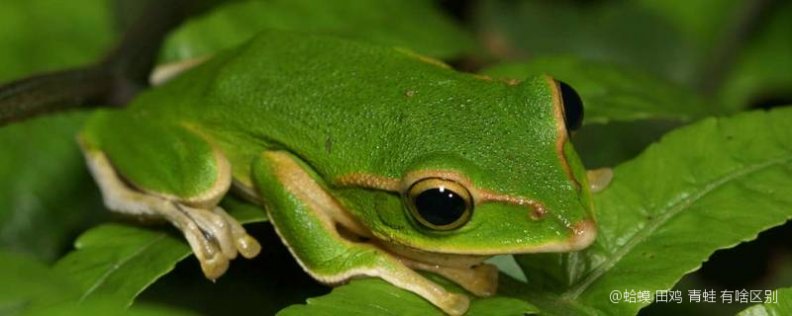请问蛤蟆 田鸡 青蛙 有啥区别?田鸡和蛤蟆的区
请问蛤蟆 田鸡 青蛙 有啥区别?田鸡和蛤蟆的区别「解析」
据和记百科网站「青栀如初」消息,近日,请问蛤蟆 田鸡 青蛙 有啥区别?田鸡和蛤蟆的区别「解析」引发热议,田鸡和蛤蟆的区别同样引起许多争议,对此众网友各抒己见。但到底是怎么回事呢?和记百科为您解答。
蛤蟆 田鸡 青蛙 有啥区别

蛤蟆、田鸡、青蛙的区别:
1、皮肤和体色不同:青蛙从眼的后方直至后肢的基部有2条纵行的皱褶,呈金黄色或浅棕色,中央有一条浅色纵纹,后肢上有很多横列的黑色斑纹,背部是褐色或黄绿色,腹面呈白色。蟾蜍皮肤粗糙,全身密布大小不等的疣状突起,背面暗褐色,腹面乳黄色。田鸡为虎纹蛙,背面黄绿色或灰棕色,背部、头侧及体侧有深色不规则的斑纹,四肢背面有深色横纹腹面白色,咽喉、胸部有灰黑色或棕色斑纹,少数斑纹达腹部。
2、毒腺不同:蟾蜍有丰富的毒腺,分皮肤腺和耳后腺。皮肤腺分布在躯体的背面,所处的表皮局部增厚成“疣粒”。耳后腺在头侧鼓膜的上方。小心用针刺破耳后腺,就流出乳白色具有毒性的浆液。青蛙,包括田鸡,没有毒腺。
3、声囊不同:青蛙和田鸡的雄蛙口角的后面有一对声囊,发声时口腔内气体压进声囊,使它扩大成球状,雌蛙没有声囊。而蟾蜍无论雌雄都没有声囊。
4、输尿管和泄殖腔的连结不同:青蛙和田鸡的2条输尿管分别跟泄殖腔相连,在泄殖腔壁上有2个开口;而蟾蜍的2根输尿管则先合并成一条总输尿管,再进入泄殖腔在泄殖腔壁上只有1个开口。
田鸡和蛤蟆的区别
田鸡和蛤蟆是两种常见的两栖动物,它们常常被人们混淆。但实际上,它们有很多明显的区别。
首先,田鸡和蛤蟆的外形就有很大差别。田鸡外形比蛤蟆小巧,通体黄褐色或者花斑,有四肢,鼓起的眼睛可以左右转动。而蛤蟆则存有很显然的扁平体形, 背部浑圆,体表平滑,呈现深灰、暗棕或者墨绿。蛤蟆身上的皮肤上有众多的疣和溪纹,让沙滩上的人们看上去就像一个个小布偶。此外,田鸡的头部圆润,口吻短;蛤蟆的头部扁平,口吻长。
其次,两者的生活习性也有所不同。田鸡在白天活动,而蛤蟆则在夜间活动。田鸡属于四肢类,习性喜好攀爬,而蛤蟆则更多的在地面或水中活动。田鸡通常在寒冬季节进入冬眠状态,而蛤蟆不需要冬眠。
最后,田鸡和蛤蟆的叫声也不同。田鸡的叫声类似“嘎-嘎-嘎”;蛤蟆则是“呱-呱-呱”的呜鸣声,有点像牛叫。
【英文介绍/For English】:
The difference between toad, frog and frog:
1. Different skin and body color: frogs have 2 longitudinal folds from the back of the eyes to the base of the hind limbs, which are golden yellow or light brown, with a light longitudinal stripe in the center, and there are many horizontal black stripes on the hind limbs. The back is brown or yellow-green and the belly is white. The toad has rough skin, densely covered with wart-like protrusions of varying sizes, dark brown on the back and creamy yellow on the ventral surface. The frog is a tiger-striped frog, with yellow-green or gray-brown back, dark irregular markings on the back, head and side, dark horizontal stripes on the back of the limbs, white on the ventral surface, gray-black or brown markings on the throat and chest, and a few markings up to the abdomen.
2. Different venom glands: Toads have abundant venom glands, which are divided into skin glands and post-auricular glands. Skin glands are distributed on the back of the body, where the epidermis is locally thickened into "warts". The post-auricular gland is above the tympanic membrane on the head. Carefully puncture the posterior auricular gland with a needle, and a milky white toxic serous fluid flows out. Frogs, including frogs, do not have poison glands.
3. Different vocal sacs: The male frogs of frogs and frogs have a pair of vocal sacs behind the mouth corners. When making sounds, the gas in the mouth is pressed into the vocal sacs, making it expand into a spherical shape. Female frogs have no vocal sacs. And toads, male or female, do not have vocal sacs.
4. The connection between the ureter and the cloaca is different: the two ureters of frog and frog are connected to the cloaca respectively, and there are two openings on the wall of the cloaca; while the two ureters of toad are first merged into a common ureter, and then enter the cloaca in the wall of the cloaca. There is only 1 opening on it.
【相关文章】
★ 种植花椒的条件






